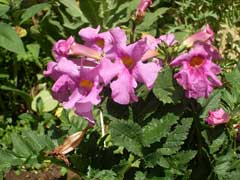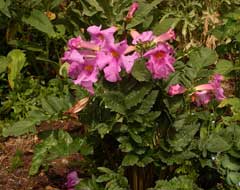 |
|
http://commons.wikimedia.org/wiki/User:FredrikL%C3%A4hnn |
 |
| http://commons.wikimedia.org/wiki/User:FredrikL%C3%A4hnn |
Translate this page:
Summary
Bloom Color: Pink. Main Bloom Time: Early summer, Late spring. Form: Rounded.
Physical Characteristics

 Incarvillea delavayi is a PERENNIAL growing to 0.4 m (1ft 4in) by 0.3 m (1ft) at a medium rate.
Incarvillea delavayi is a PERENNIAL growing to 0.4 m (1ft 4in) by 0.3 m (1ft) at a medium rate.
See above for USDA hardiness. It is hardy to UK zone 6. It is in flower from May to June. The species is hermaphrodite (has both male and female organs).
Suitable for: light (sandy) and medium (loamy) soils and prefers well-drained soil. Suitable pH: neutral and basic (mildly alkaline) soils. It can grow in semi-shade (light woodland) or no shade. It prefers moist soil and can tolerate drought.
UK Hardiness Map
US Hardiness Map
Synonyms
Plant Habitats
Cultivated Beds;
Edible Uses
Edible Parts: Leaves Shoots
Edible Uses:
Leaves and young shoots - cooked. A famine food, it is only used when all else fails[179]. Some caution is advised, see the notes above on toxicity.
References More on Edible Uses
Medicinal Uses
Plants For A Future can not take any responsibility for any adverse effects from the use of plants. Always seek advice from a professional before using a plant medicinally.
None known
References More on Medicinal Uses
The Bookshop: Edible Plant Books
Our Latest books on Perennial Plants For Food Forests and Permaculture Gardens in paperback or digital formats.

Edible Tropical Plants
Food Forest Plants for Hotter Conditions: 250+ Plants For Tropical Food Forests & Permaculture Gardens.
More

Edible Temperate Plants
Plants for Your Food Forest: 500 Plants for Temperate Food Forests & Permaculture Gardens.
More

More Books
PFAF have eight books available in paperback and digital formats. Browse the shop for more information.
Shop Now
Other Uses
References More on Other Uses
Cultivation details
Landscape Uses:Alpine garden, Border, Container, Rock garden, Specimen. Easily grown in a deep sandy but rich soil in full sun[187, 200]. Plants grow better if given some shade around midday[200]. Prefers a well-drained calcareous or neutral soil[214] and is drought tolerant when established[190]. Another report says that it dislikes dry summer soils[200]. Dislikes winter wet[200]. Prefers a sheltered position[214]. Plants are hardy to about -15°c, tolerating even lower temperatures if the roots are well mulched, preferably with dry bracken[1, 187, 200]. The crown of the plant requires protection from slugs in the winter[187]. A very ornamental plant, it usually takes about 3 - 4 years to come into flower from seed[214]. This species is often confused in cultivation with I. mairei[214]. Plants are intolerant of root disturbance, it is best to place them in their permanent positions whilst small[200]. The plants will often sulk for several years if they are divided[214]. Special Features:
Attractive foliage.
References Carbon Farming Information and Carbon Sequestration Information
Temperature Converter
Type a value in the Celsius field to convert the value to Fahrenheit:
Fahrenheit:
The PFAF Bookshop
Plants For A Future have a number of books available in paperback and digital form. Book titles include Edible Plants, Edible Perennials, Edible Trees,Edible Shrubs, Woodland Gardening, and Temperate Food Forest Plants. Our new book is Food Forest Plants For Hotter Conditions (Tropical and Sub-Tropical).
Shop Now
Plant Propagation
Seed - sow autumn or spring in a greenhouse. Prick out the seedlings into individual pots as soon as they are large enough to handle. Grow on for at least their first winter in a greenhouse and plant out into their permanent positions in spring after the last expected frosts. Division with care in early spring or autumn.
Other Names
If available other names are mentioned here
Native Range
TEMPERATE ASIA: China (Sichuan Sheng, Yunnan Sheng (northwest))
Weed Potential
Right plant wrong place. We are currently updating this section.
Please note that a plant may be invasive in one area but may not in your area so it's worth checking.
Conservation Status
IUCN Red List of Threatened Plants Status :

Growth: S = slow M = medium F = fast. Soil: L = light (sandy) M = medium H = heavy (clay). pH: A = acid N = neutral B = basic (alkaline). Shade: F = full shade S = semi-shade N = no shade. Moisture: D = dry M = Moist We = wet Wa = water.
Now available:
Food Forest Plants for Mediterranean Conditions
350+ Perennial Plants For Mediterranean and Drier Food Forests and Permaculture Gardens.
[Paperback and eBook]
This is the third in Plants For A Future's series of plant guides for food forests tailored to
specific climate zones. Following volumes on temperate and tropical ecosystems, this book focuses
on species suited to Mediterranean conditions—regions with hot, dry summers and cool, wet winters,
often facing the added challenge of climate change.
Read More
Expert comment
Author
Bur.&Franch.
Botanical References
200266
Links / References
For a list of references used on this page please go here
Readers comment
| Add a comment |
|
If you have important information about this plant that may help other users please add a comment or link below. Only comments or links that are felt to be directly relevant to a plant will be included. If you think a comment/link or information contained on this page is inaccurate or misleading we would welcome your feedback at [email protected]. If you have questions about a plant please use the Forum on this website as we do not have the resources to answer questions ourselves.
* Please note: the comments by website users are not necessarily those held by PFAF and may give misleading or inaccurate information.
To leave a comment please Register or login here All comments need to be approved so will not appear immediately.
|
Subject : Incarvillea delavayi
|
|
|
|